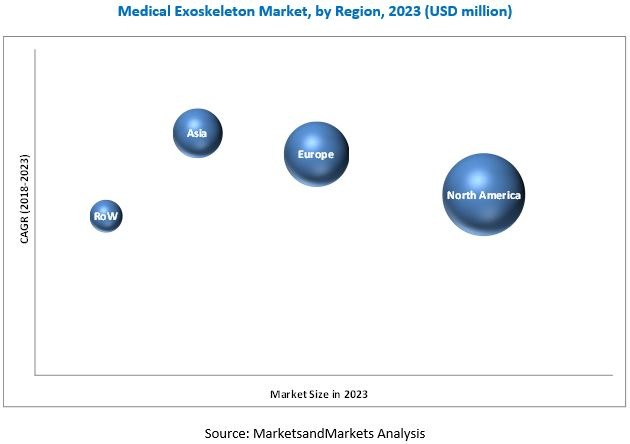Factors such as the increasing number of people with physical disabilities and subsequent growth in the demand for effective rehabilitation approaches and increasing insurance coverage for medical exoskeletons in several countries are driving the growth of the medical exoskeleton market. The report segments the market into component, type, mobility, extremity, and region.
The global medical exoskeleton market is expected to reach USD 571.6 million by 2023 from USD 116.7 million in 2018, at a CAGR of 37.4%.
Increasing number of people with physical disabilities and subsequent growth in the demand for effective rehabilitation approaches
Globally, the number of people with physical disabilities is increasing majorly due to the rising geriatric population, increasing number of road accidents and severe trauma injuries, and increasing prevalence of stroke, among other factors. According to the US Census Bureau, the global elderly population is estimated to increase at a steady pace in the coming years, from 900.9 million in 2015 to 1,402.4 million by 2030, and 2,092.0 million by 2050. All major regions across the globe are witnessing a significant growth in their geriatric populations, and this trend is expected to continue in the coming years.
Download PDF Brochure:
https://www.marketsandmarkets.com/pdfdownloadNew.asp?id=138546702

Industry Segmentation in Depth: –
The market, by component, is segmented into hardware and software. In 2018, the software segment is expected to register the highest CAGR during the forecast period. The adoption of medical exoskeleton software is increasing as these solutions offer OS–like functionalities and provide services such as hardware abstraction, low-level device control, implementation of commonly-used functionality, message-passing between processes, and package management.
By type, the medical exoskeleton market is segmented into powered and passive exoskeletons. In 2018, the powered exoskeletons segment is expected to register the highest CAGR during the forecast period. The presence of sensors and various controlling functions in powered exoskeletons to sense motion, tilt, and speed is the key factor driving the growth of this segment.
The market, by mobility, is segmented into stationary medical exoskeletons and mobile medical exoskeletons. In 2018, the mobile medical exoskeletons segment is expected to register the highest CAGR during the forecast period. This growth can be attributed to the high demand for compact, light-weight mobile medical exoskeletons that can offer mobility assistance to paralyzed patients
Request Research Sample Pages: https://www.marketsandmarkets.com/requestsampleNew.asp?id=138546702
Geographical Overview:
The Asian medical exoskeletons market is expected to register the highest CAGR during the forecast period. The growing geriatric and physically disabled population, large population base, increase in disposable income, and the presence of prominent manufacturers in this region are some of the key factors driving the growth of the medical exoskeleton market in Asia.
Leading Key Players operating in the Market:
Ekso Bionics Holdings, Inc. (US), ReWalk Robotics Ltd (Israel), Parker Hannifin Corp (US), Bionik Laboratories Corp (Canada), CYBERDYNE Inc. (Japan), Rex Bionics Ltd. (UK), B-TEMIA Inc. (Canada), Hocoma AG (A Subsidiary of DIH Technologies) (Switzerland), Wearable Robotics SRL (Italy), Gogoa Mobility Robots SL (Spain), and ExoAtlet, O.O.O. (Russia)).
